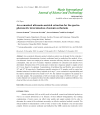

Assuming that the true value of is not known to us, our problem is then to decide as soon as possible and with a minimal error probability (both specified later) if the true value of is either 0 or 1. Description of the problem Suppose that at time t=0 we begin to observe a Poisson process X = (Xt)t 0 with intensity>0 which is either 0 or 1 where 0 < 1. A rigorous proof of the optimality of the Wald’s sequential probability ratio test in the variational formulation of the problem is obtained as a consequence of the solution of the Bayesian problem. The method of proof consists of reducing the initial problem to a free-boundary differential-difference Stephan problem, and solving the latter by use of the principles of smooth and continuous fit. "Statistical Methods in Online A/B Testing" by the author of this glossary, Georgi Georgiev.We present the explicit solution of the Bayesian problem of sequential testing of two simple hypotheses about the intensity of an observed Poisson process. Like this glossary entry? For an in-depth and comprehensive reading on A/B testing stats, check out the book For most cases there exist near-unbiased estimators with good properties.

The bias-reduction methods are closely linked to the type of spending functions employed.
#Two stage sequential testing trial#
Crossing one of the boundaries results in stopping the trial with a decision to reject or to accept the null hypothesis. The boundaries can be maintained even when one deviates from the original design in terms of number and timings of interim analyses. The two functions produce two decision boundaries, an efficacy boundary limiting the test statistic ( z score) from above and a futility boundary limiting it from below. The control of type I errors is achieved by way of an alpha-spending function while control of the type II error rate is handled by a beta-spending function.

This also introduces bias and requires the use of bias-reducing / bias-correcting techniques as the sample mean is no longer the maximum likelihood estimate. Implementing a winning variant as quickly as possible is desirable and so is stopping a test which has little chance of demonstrating an effect or is in fact actively harming the users exposed to the treatment.Ī drawback is the increased computational complexity since the stopping time itself is now a random variable and needs to be accounted for in an adequate statistical model in order to draw valid conclusions. The added flexibility in the form of the ability to analyze the data as it gathers is also highly desirable as a form of reducing business risk and of opportunity costs. For example, one can cut down test duration / sample size by 20-80% (see article references) while maintaining error probability. The benefits of a sequential testing approach is the improved efficiency of the test. They can also be performed by using an adaptive sequential design when necessary, although it offers no efficiency improvements and are much more complex. Sequential testing is usually done by using a so-called group-sequential design (GSD) and sometimes such tests are called group-sequential trials (GST) or group-sequential tests. This should not be mistaken with unaccounted peeking at the data with intent to stop. Sequential testing employs optional stopping rules ( error-spending functions) that guarantee the overall type I error rate of the procedure. Sequential testing is the practice of making decision during an A/B test by sequentially monitoring the data as it accrues. Aliases: sequential monitoring, group-sequential design, GSD, GST


 0 kommentar(er)
0 kommentar(er)
